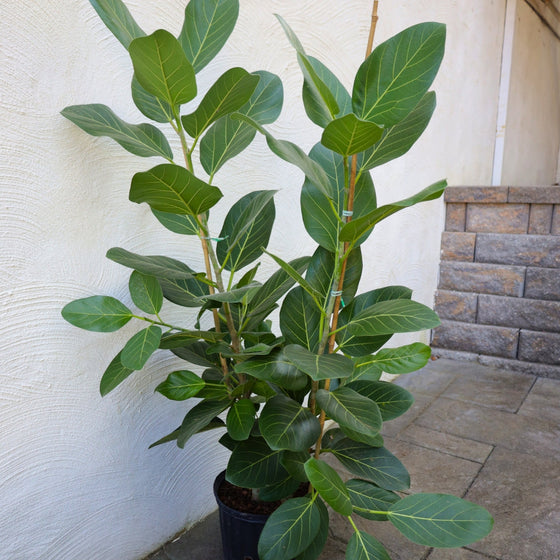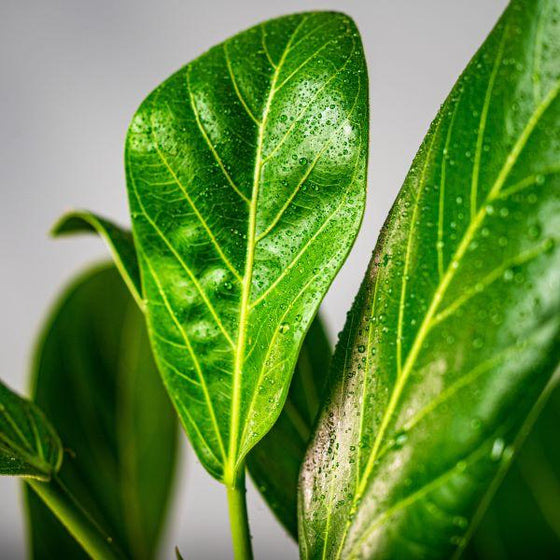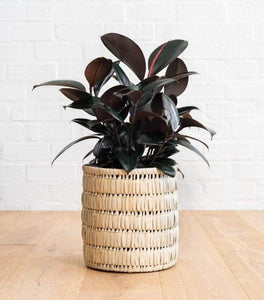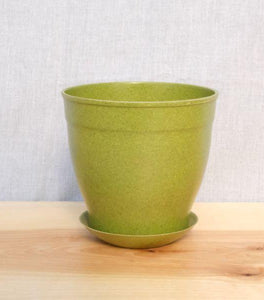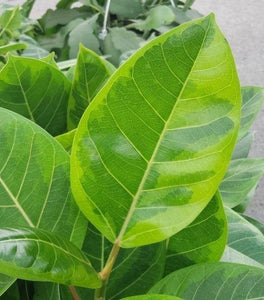
Images Depicted Range in Maturity & Container Size
Pots & Decorations Not Included Unless Otherwise Stated
Ficus Audrey Tree for Sale Online
The Audrey Ficus Tree (Ficus benghalensis) is a houseplant quickly growing in popularity. Its large leaves are similar to that of a rubber plant, with pale green veins that contrast beautifully against the emerald green tone of the leaf.
This particular Ficus is a beautiful addition to any home. Some choose Audrey Ficus plants over Fiddle Leaf Figs due to their ease of care and similarity in appearance, making them a wonderful option for beginner plant parents. Thriving in bright indirect sunlight and requiring fertilization just once a month during the growing season, the Audrey Ficus affords great ease in care to its owners.
The Ficus Audrey Tree is native to India and is one of the largest trees in the world by canopy coverage. It is said it was a place of comfort for Buddha to sit beneath during his historical 49-day meditation. Filtering airborne toxins from the home, the Ficus Audrey plant is the perfect household plant addition.
Take caution with children and animals as the sap from Ficus leaves is an irritant, and the plant can be toxic. If you want to plant it outdoors, it may be grown in Zones 9-11.

| Hardiness Zone: | 9-11 |
|---|---|
| Mature Height: | 5 to 6 Feet |
| Mature Width: | 2 to 3 Feet |
| Sunlight: | Indirect sunlight |
| Indoor Temperature: | 60 to 70 F |
| Humidity Level: | Prefers a humid environment, mist occasionally |
| Water Requirements: | Keep soil most and allow topsoil to dry out between watering |
How to Care for Ficus Audrey
Be sure to read our planting instructions to ensure a healthy and happy plant for years to come!
How to water Ficus Audrey Plants?
Ficus Audrey Plants prefer soil that is consistently and evenly moist. Allow small periods of drought between watering, permitting the top 2 to 3 inches of soil to dry. Drought will result in leaf loss but excessive moisture will result in root rot, also causing leaves to drop. The Ficus Audrey Plant does well in self-watering containers for added ease.

How do I prune my Ficus Audrey Plant?
Your Ficus Audrey Tree will look fuller with occasional pruning to shape leggy branches, and can be shaped as desired. Dead branches or broken branches may be pruned any time of the year. Overall pruning is recommended during the fall once the Audrey Ficus Plants growth has gone dormant for the year. In the event your Ficus Audrey Plant develops erratic irregular juvenile growth, prune for shape and balance. The Ficus Audrey Tree will leak sap from cut branches so take caution within your home after pruning and wash well if your skin is exposed as it can be an irritant.
How to fertilize Ficus Audrey Plants?
Fertilize your Ficus Audrey Tree about once a month with a water soluble houseplant fertilizer such as Jack's Classic. In our opinion, it is best best to water monthly with the low rate as specified on the fertilizer label. This will avoid buildup of salts in the soil from over fertilization. It's best not to feed indoor plants during the winter months as the plant will not be in an active state of growth and therefore will not require as many nutrients. To put it simply, avoid feeding when it is not in active growth, usually in winter. Refrain from fertilizing a plant with a chemical fertilizer if the plant appears sick or wilted. When in poor health, the fertilizer will only add stress to the plant. It is best to treat and cure the problem prior to adding fertilizer. Proper fertilization of your Ficus Audrey Bush will lead to healthier and more disease resistant plant, resulting in a longer living houseplant.
How to repot Ficus Audrey Plants?
Ficus Audrey Plants will need to be repotted every one to three years depending on the root growth. The potting vessel typically will be 2 to 4 inches larger in diameter to allow for ample growth. Too large and you risk drawing the plant roots. If the current size planter is desired, repot into the same vessel after providing new soil and trimming away some roots and foliage. Spring or summer is the ideal time to repot as the plant is at its strongest.

